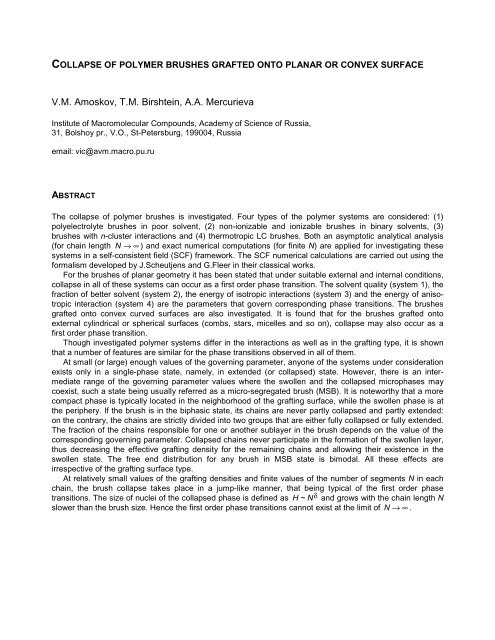Collapse of polymer brushes grafted onto planar ... - Wageningen UR
Collapse of polymer brushes grafted onto planar ... - Wageningen UR
Collapse of polymer brushes grafted onto planar ... - Wageningen UR
You also want an ePaper? Increase the reach of your titles
YUMPU automatically turns print PDFs into web optimized ePapers that Google loves.
COLLAPSE OF POLYMER BRUSHES GRAFTED ONTO PLANAR OR CONVEX S<strong>UR</strong>FACE<br />
V.M. Amoskov, T.M. Birshtein, A.A. Mercurieva<br />
Institute <strong>of</strong> Macromolecular Compounds, Academy <strong>of</strong> Science <strong>of</strong> Russia,<br />
31, Bolshoy pr., V.O., St-Petersburg, 199004, Russia<br />
email: vic@avm.macro.pu.ru<br />
ABSTRACT<br />
The collapse <strong>of</strong> <strong>polymer</strong> <strong>brushes</strong> is investigated. Four types <strong>of</strong> the <strong>polymer</strong> systems are considered: (1)<br />
polyelectrolyte <strong>brushes</strong> in poor solvent, (2) non-ionizable and ionizable <strong>brushes</strong> in binary solvents, (3)<br />
<strong>brushes</strong> with n-cluster interactions and (4) thermotropic LC <strong>brushes</strong>. Both an asymptotic analytical analysis<br />
(for chain length N →∞)<br />
and exact numerical computations (for finite N) are applied for investigating these<br />
systems in a self-consistent field (SCF) framework. The SCF numerical calculations are carried out using the<br />
formalism developed by J.Scheutjens and G.Fleer in their classical works.<br />
For the <strong>brushes</strong> <strong>of</strong> <strong>planar</strong> geometry it has been stated that under suitable external and internal conditions,<br />
collapse in all <strong>of</strong> these systems can occur as a first order phase transition. The solvent quality (system 1), the<br />
fraction <strong>of</strong> better solvent (system 2), the energy <strong>of</strong> isotropic interactions (system 3) and the energy <strong>of</strong> anisotropic<br />
interaction (system 4) are the parameters that govern corresponding phase transitions. The <strong>brushes</strong><br />
<strong>grafted</strong> <strong>onto</strong> convex curved surfaces are also investigated. It is found that for the <strong>brushes</strong> <strong>grafted</strong> <strong>onto</strong><br />
external cylindrical or spherical surfaces (combs, stars, micelles and so on), collapse may also occur as a<br />
first order phase transition.<br />
Though investigated <strong>polymer</strong> systems differ in the interactions as well as in the grafting type, it is shown<br />
that a number <strong>of</strong> features are similar for the phase transitions observed in all <strong>of</strong> them.<br />
At small (or large) enough values <strong>of</strong> the governing parameter, anyone <strong>of</strong> the systems under consideration<br />
exists only in a single-phase state, namely, in extended (or collapsed) state. However, there is an intermediate<br />
range <strong>of</strong> the governing parameter values where the swollen and the collapsed microphases may<br />
coexist, such a state being usually referred as a micro-segregated brush (MSB). It is noteworthy that a more<br />
compact phase is typically located in the neighborhood <strong>of</strong> the grafting surface, while the swollen phase is at<br />
the periphery. If the brush is in the biphasic state, its chains are never partly collapsed and partly extended:<br />
on the contrary, the chains are strictly divided into two groups that are either fully collapsed or fully extended.<br />
The fraction <strong>of</strong> the chains responsible for one or another sublayer in the brush depends on the value <strong>of</strong> the<br />
corresponding governing parameter. <strong>Collapse</strong>d chains never participate in the formation <strong>of</strong> the swollen layer,<br />
thus decreasing the effective grafting density for the remaining chains and allowing their existence in the<br />
swollen state. The free end distribution for any brush in MSB state is bimodal. All these effects are<br />
irrespective <strong>of</strong> the grafting surface type.<br />
At relatively small values <strong>of</strong> the grafting densities and finite values <strong>of</strong> the number <strong>of</strong> segments N in each<br />
chain, the brush collapse takes place in a jump-like manner, that being typical <strong>of</strong> the first order phase<br />
transitions. The size <strong>of</strong> nuclei <strong>of</strong> the collapsed phase is defined as H ~ N δ and grows with the chain length N<br />
slower than the brush size. Hence the first order phase transitions cannot exist at the limit <strong>of</strong> N →∞.

















